differential Seat Ibiza ST 2015 Owner's manual
[x] Cancel search | Manufacturer: SEAT, Model Year: 2015, Model line: Ibiza ST, Model: Seat Ibiza ST 2015Pages: 248, PDF Size: 4.77 MB
Page 105 of 248
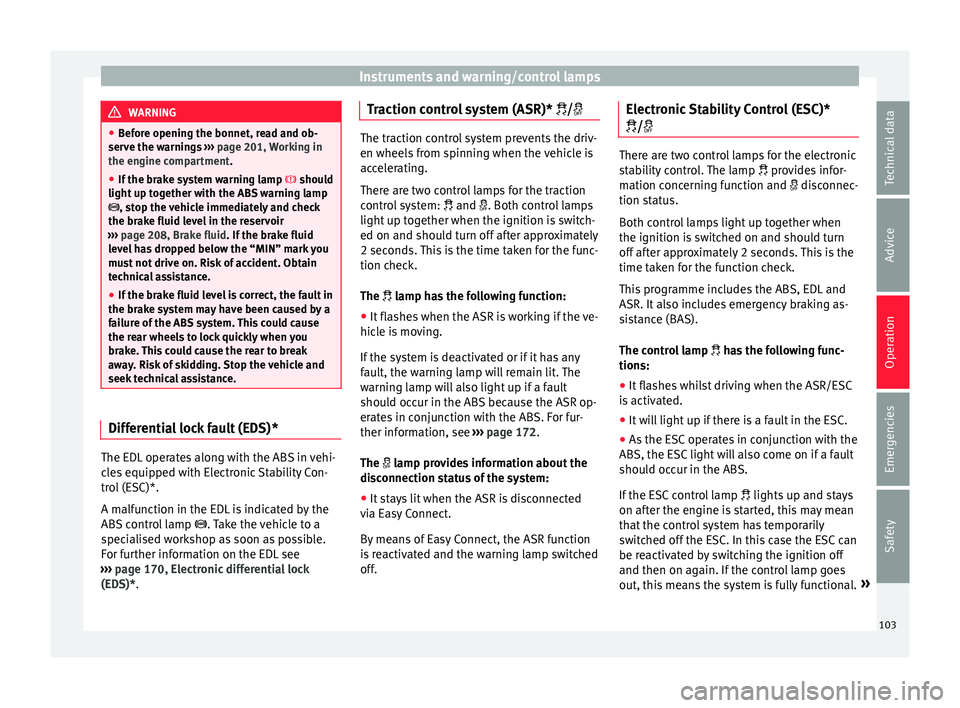
Instruments and warning/control lamps
WARNING
● Bef or
e opening the bonnet, read and ob-
serve the warnings ››› page 201, Working in
the engine compartment.
● If the brake system warning lamp should
light
up together with the ABS warning lamp
, stop the vehicle immediately and check
the brake fluid level in the reservoir
››› page 208, Brake fluid. If the brake fluid
level has dropped below the “MIN” mark you
must not drive on. Risk of accident. Obtain
technical assistance.
● If the brake fluid level is correct, the fault in
the brake sy
stem may have been caused by a
failure of the ABS system. This could cause
the rear wheels to lock quickly when you
brake. This could cause the rear to break
away. Risk of skidding. Stop the vehicle and
seek technical assistance. Differential lock fault (EDS)*
The EDL operates along with the ABS in vehi-
c
l
e
s equipped with Electronic Stability Con-
trol (ESC)*.
A malfunction in the EDL is indicated by the
ABS control lamp . Take the vehicle to a
specialised workshop as soon as possible.
For further information on the EDL see
››› page 170, Electronic differential lock
(EDS)*. Traction control system (ASR)* / The traction control system prevents the driv-
en wheels
fr
om spinning when the vehicle is
accelerating.
There are two control lamps for the traction
control system: and . Both control lamps
light up together when the ignition is switch-
ed on and should turn off after approximately
2 seconds. This is the time taken for the func-
tion check.
The lamp has the following function:
● It flashes when the ASR is working if the ve-
hicl e i
s moving.
If the system is deactivated or if it has any
fault, the warning lamp will remain lit. The
warning lamp will also light up if a fault
should occur in the ABS because the ASR op-
erates in conjunction with the ABS. For fur-
ther information, see ›››
page 172.
The lamp provides information about the
disconnection status of the system:
● It stays lit when the ASR is disconnected
via E
asy Connect.
By means of Easy Connect, the ASR function
is reactivated and the warning lamp switched
off. Electronic Stability Control (ESC)*
/ There are two control lamps for the electronic
st
ab
ility control. The lamp provides infor-
mation concerning function and disconnec-
tion status.
Both control lamps light up together when
the ignition is switched on and should turn
off after approximately 2 seconds. This is the
time taken for the function check.
This programme includes the ABS, EDL and
ASR. It also includes emergency braking as-
sistance (BAS).
The control lamp has the following func-
tions:
● It flashes whilst driving when the ASR/ESC
is activ
ated.
● It will light up if there is a fault in the ESC.
● As the ESC operates in conjunction with the
ABS, the ESC light
will also come on if a fault
should occur in the ABS.
If the ESC control lamp lights up and stays
on after the engine is started, this may mean
that the control system has temporarily
switched off the ESC. In this case the ESC can
be reactivated by switching the ignition off
and then on again. If the control lamp goes
out, this means the system is fully functional. »
103
Technical data
Advice
Operation
Emergencies
Safety
Page 172 of 248
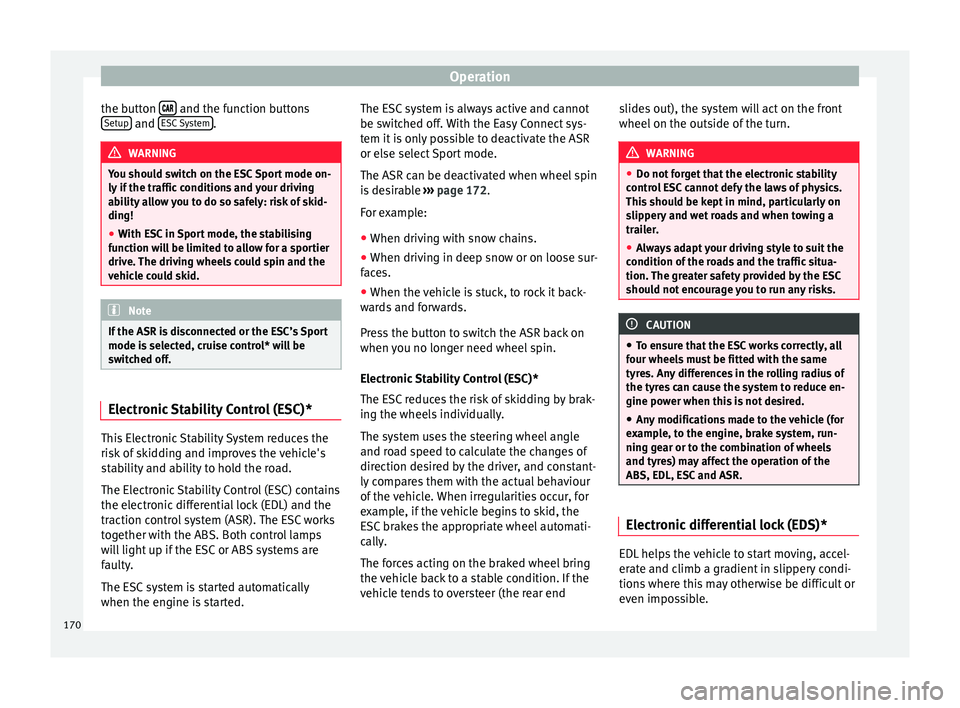
Operation
the button
and the function buttons
Set up and
E
SC
System .
WARNING
You should switch on the ESC Sport mode on-
ly if the tr
affic conditions and your driving
ability allow you to do so safely: risk of skid-
ding!
● With ESC in Sport mode, the stabilising
function w
ill be limited to allow for a sportier
drive. The driving wheels could spin and the
vehicle could skid. Note
If the ASR is disconnected or the ESC’s Sport
mode is sel
ected, cruise control* will be
switched off. Electronic Stability Control (ESC)*
This Electronic Stability System reduces the
ri
sk
of
skidding and improves the vehicle's
stability and ability to hold the road.
The Electronic Stability Control (ESC) contains
the electronic differential lock (EDL) and the
traction control system (ASR). The ESC works
together with the ABS. Both control lamps
will light up if the ESC or ABS systems are
faulty.
The ESC system is started automatically
when the engine is started. The ESC system is always active and cannot
be switc
hed off. With the Easy Connect sys-
tem it is only possible to deactivate the ASR
or else select Sport mode.
The ASR can be deactivated when wheel spin
is desirable ››› page 172.
For example:
● When driving with snow chains.
● When driving in deep snow or on loose sur-
face
s.
● When the vehicle is stuck, to rock it back-
ward
s and forwards.
Press the button to switch the ASR back on
when you no longer need wheel spin.
Electronic Stability Control (ESC)*
The ESC reduces the risk of skidding by brak-
ing the wheels individually.
The system uses the steering wheel angle
and road speed to calculate the changes of
direction desired by the driver, and constant-
ly compares them with the actual behaviour
of the vehicle. When irregularities occur, for
example, if the vehicle begins to skid, the
ESC brakes the appropriate wheel automati-
cally.
The forces acting on the braked wheel bring
the vehicle back to a stable condition. If the
vehicle tends to oversteer (the rear end slides out), the system will act on the front
wheel on the outside of
the turn. WARNING
● Do not f or
get that the electronic stability
control ESC cannot defy the laws of physics.
This should be kept in mind, particularly on
slippery and wet roads and when towing a
trailer.
● Always adapt your driving style to suit the
condition of the r
oads and the traffic situa-
tion. The greater safety provided by the ESC
should not encourage you to run any risks. CAUTION
● To en s
ure that the ESC works correctly, all
four wheels must be fitted with the same
tyres. Any differences in the rolling radius of
the tyres can cause the system to reduce en-
gine power when this is not desired.
● Any modifications made to the vehicle (for
examp
le, to the engine, brake system, run-
ning gear or to the combination of wheels
and tyres) may affect the operation of the
ABS, EDL, ESC and ASR. Electronic differential lock (EDS)*
EDL helps the vehicle to start moving, accel-
er
at
e and c
limb a gradient in slippery condi-
tions where this may otherwise be difficult or
even impossible.
170
Page 173 of 248
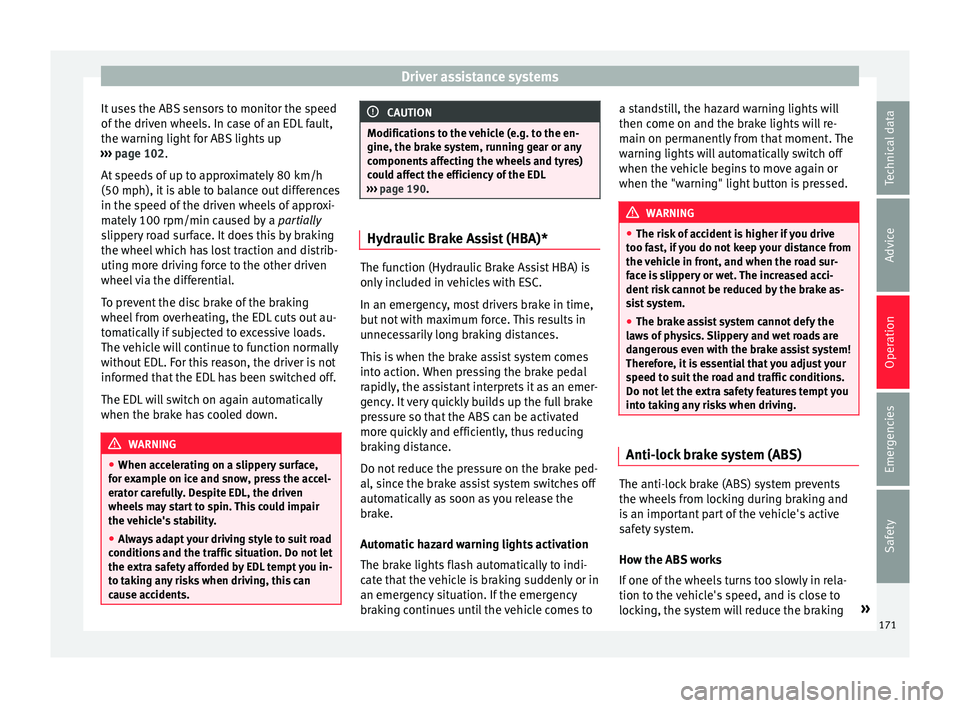
Driver assistance systems
It uses the ABS sensors to monitor the speed
of the driv
en wheel
s. In case of an EDL fault,
the warning light for ABS lights up
››› page 102.
At speeds of up to approximately 80 km/h
(50 mph), it is able to balance out differences
in the speed of the driven wheels of approxi-
mately 100 rpm/min caused by a partially
slippery road surface. It does this by braking
the wheel which has lost traction and distrib-
uting more driving force to the other driven
wheel via the differential.
To prevent the disc brake of the braking
wheel from overheating, the EDL cuts out au-
tomatically if subjected to excessive loads.
The vehicle will continue to function normally
without EDL. For this reason, the driver is not
informed that the EDL has been switched off.
The EDL will switch on again automatically
when the brake has cooled down. WARNING
● When acc el
erating on a slippery surface,
for example on ice and snow, press the accel-
erator carefully. Despite EDL, the driven
wheels may start to spin. This could impair
the vehicle's stability.
● Always adapt your driving style to suit road
conditions
and the traffic situation. Do not let
the extra safety afforded by EDL tempt you in-
to taking any risks when driving, this can
cause accidents. CAUTION
Modifications to the vehicle (e.g. to the en-
gine, the brak e sy
stem, running gear or any
components affecting the wheels and tyres)
could affect the efficiency of the EDL
››› page 190. Hydraulic Brake Assist (HBA)*
The function (Hydraulic Brake Assist HBA) is
only
inc
luded in vehicles with ESC.
In an emergency, most drivers brake in time,
but not with maximum force. This results in
unnecessarily long braking distances.
This is when the brake assist system comes
into action. When pressing the brake pedal
rapidly, the assistant interprets it as an emer-
gency. It very quickly builds up the full brake
pressure so that the ABS can be activated
more quickly and efficiently, thus reducing
braking distance.
Do not reduce the pressure on the brake ped-
al, since the brake assist system switches off
automatically as soon as you release the
brake.
Automatic hazard warning lights activation
The brake lights flash automatically to indi-
cate that the vehicle is braking suddenly or in
an emergency situation. If the emergency
braking continues until the vehicle comes to a standstill, the hazard warning lights will
then come on and the br
ak
e lights will re-
main on permanently from that moment. The
warning lights will automatically switch off
when the vehicle begins to move again or
when the "warning" light button is pressed. WARNING
● The risk of
accident is higher if you drive
too fast, if you do not keep your distance from
the vehicle in front, and when the road sur-
face is slippery or wet. The increased acci-
dent risk cannot be reduced by the brake as-
sist system.
● The brake assist system cannot defy the
law
s of physics. Slippery and wet roads are
dangerous even with the brake assist system!
Therefore, it is essential that you adjust your
speed to suit the road and traffic conditions.
Do not let the extra safety features tempt you
into taking any risks when driving. Anti-lock brake system (ABS)
The anti-lock brake (ABS) system prevents
the wheel
s
fr
om locking during braking and
is an important part of the vehicle's active
safety system.
How the ABS works
If one of the wheels turns too slowly in rela-
tion to the vehicle's speed, and is close to
locking, the system will reduce the braking »
171
Technical data
Advice
Operation
Emergencies
Safety
Page 175 of 248
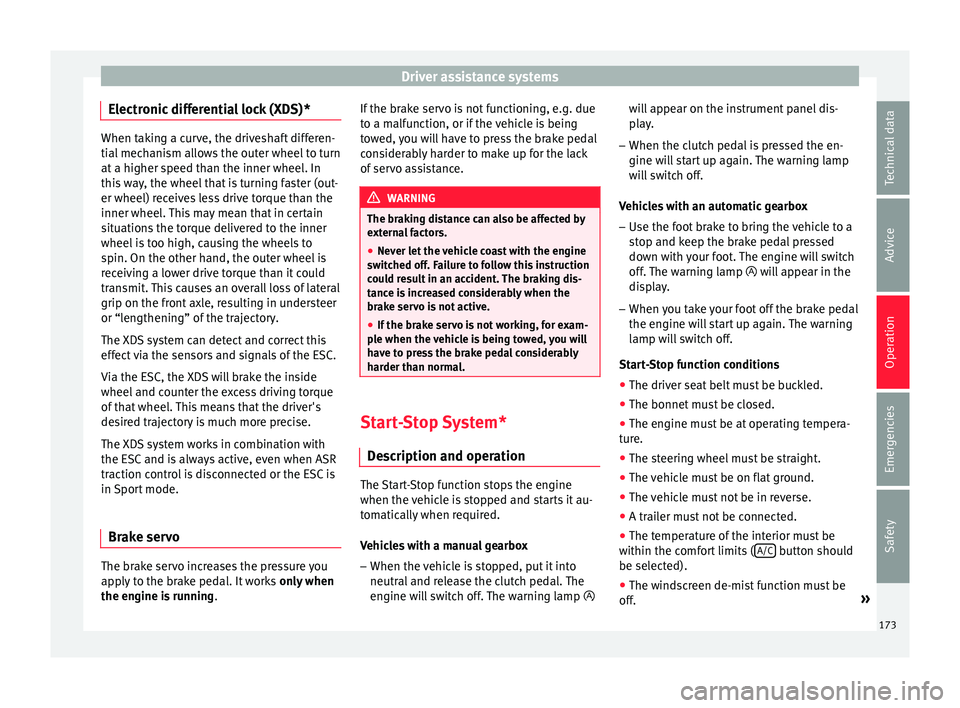
Driver assistance systems
Electronic differential lock (XDS)* When taking a curve, the driveshaft differen-
tial
mec
hanism allows the outer wheel to turn
at a higher speed than the inner wheel. In
this way, the wheel that is turning faster (out-
er wheel) receives less drive torque than the
inner wheel. This may mean that in certain
situations the torque delivered to the inner
wheel is too high, causing the wheels to
spin. On the other hand, the outer wheel is
receiving a lower drive torque than it could
transmit. This causes an overall loss of lateral
grip on the front axle, resulting in understeer
or “lengthening” of the trajectory.
The XDS system can detect and correct this
effect via the sensors and signals of the ESC.
Via the ESC, the XDS will brake the inside
wheel and counter the excess driving torque
of that wheel. This means that the driver's
desired trajectory is much more precise.
The XDS system works in combination with
the ESC and is always active, even when ASR
traction control is disconnected or the ESC is
in Sport mode.
Brake servo The brake servo increases the pressure you
ap
p
ly
to the brake pedal. It works only when
the engine is running . If the brake servo is not functioning, e.g. due
to a malf
unction, or if the vehicle is being
towed, you will have to press the brake pedal
considerably harder to make up for the lack
of servo assistance. WARNING
The braking distance can also be affected by
ext ern
al factors.
● Never let the vehicle coast with the engine
switc
hed off. Failure to follow this instruction
could result in an accident. The braking dis-
tance is increased considerably when the
brake servo is not active.
● If the brake servo is not working, for exam-
ple when the
vehicle is being towed, you will
have to press the brake pedal considerably
harder than normal. Start-Stop System*
D e
s
cription and operation The Start-Stop function stops the engine
when the
v
ehic
le is stopped and starts it au-
tomatically when required.
Vehicles with a manual gearbox
– When the vehicle is stopped, put it into
neutral and r
elease the clutch pedal. The
engine will switch off. The warning lamp will appear on the instrument panel dis-
pla
y.
– When the clutch pedal is pressed the en-
gine wil
l start up again. The warning lamp
will switch off.
Vehicles with an automatic gearbox – Use the foot brake to bring the vehicle to a
stop and k
eep the brake pedal pressed
down with your foot. The engine will switch
off. The warning lamp will appear in the
display.
– When you take your foot off the brake pedal
the engine wi
ll start up again. The warning
lamp will switch off.
Start-Stop function conditions
● The driver seat belt must be buckled.
● The bonnet must be closed.
● The engine must be at operating tempera-
ture.
● The s
teering wheel must be straight.
● The vehicle must be on flat ground.
● The vehicle must not be in reverse.
● A trailer must not be connected.
● The temperature of the interior must be
within the comf
ort limits (A/C button should
be sel ect
ed).
● The w
indscreen de-mist function must be
off. »
173
Technical data
Advice
Operation
Emergencies
Safety
Page 239 of 248
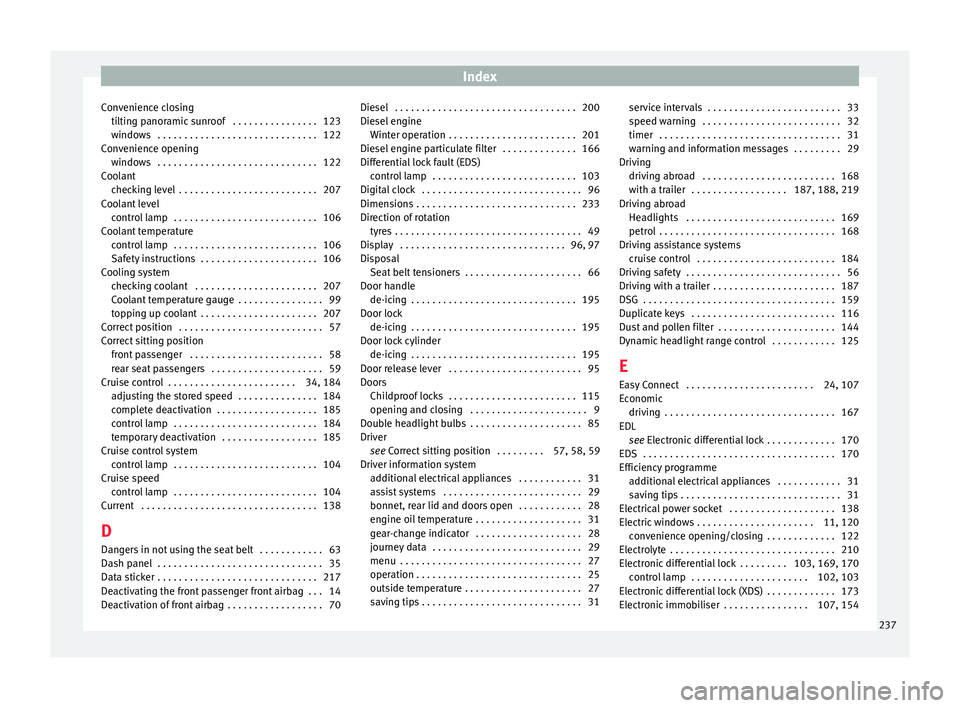
Index
Convenience closing tiltin
g p
anoramic sunroof . . . . . . . . . . . . . . . . 123
windows . . . . . . . . . . . . . . . . . . . . . . . . . . . . . . 122
Convenience opening windows . . . . . . . . . . . . . . . . . . . . . . . . . . . . . . 122
Coolant checking level . . . . . . . . . . . . . . . . . . . . . . . . . . 207
Coolant level control lamp . . . . . . . . . . . . . . . . . . . . . . . . . . . 106
Coolant temperature control lamp . . . . . . . . . . . . . . . . . . . . . . . . . . . 106
Safety instructions . . . . . . . . . . . . . . . . . . . . . . 106
Cooling system checking coolant . . . . . . . . . . . . . . . . . . . . . . . 207
Coolant temperature gauge . . . . . . . . . . . . . . . . 99
topping up coolant . . . . . . . . . . . . . . . . . . . . . . 207
Correct position . . . . . . . . . . . . . . . . . . . . . . . . . . . 57
Correct sitting position front passenger . . . . . . . . . . . . . . . . . . . . . . . . . 58
rear seat passengers . . . . . . . . . . . . . . . . . . . . . 59
Cruise control . . . . . . . . . . . . . . . . . . . . . . . . 34, 184 adjusting the stored speed . . . . . . . . . . . . . . . 184
complete deactivation . . . . . . . . . . . . . . . . . . . 185
control lamp . . . . . . . . . . . . . . . . . . . . . . . . . . . 184
temporary deactivation . . . . . . . . . . . . . . . . . . 185
Cruise control system control lamp . . . . . . . . . . . . . . . . . . . . . . . . . . . 104
Cruise speed control lamp . . . . . . . . . . . . . . . . . . . . . . . . . . . 104
Current . . . . . . . . . . . . . . . . . . . . . . . . . . . . . . . . . 138
D Dangers in not using the seat belt . . . . . . . . . . . . 63
Dash panel . . . . . . . . . . . . . . . . . . . . . . . . . . . . . . . 35
Data sticker . . . . . . . . . . . . . . . . . . . . . . . . . . . . . . 217
Deactivating the front passenger front airbag . . . 14
Deactivation of front airbag . . . . . . . . . . . . . . . . . . 70 Diesel . . . . . . . . . . . . . . . . . . . . . . . . . . . . . . . . . . 200
Diesel en
gine
Winter operation . . . . . . . . . . . . . . . . . . . . . . . . 201
Diesel engine particulate filter . . . . . . . . . . . . . . 166
Differential lock fault (EDS) control lamp . . . . . . . . . . . . . . . . . . . . . . . . . . . 103
Digital clock . . . . . . . . . . . . . . . . . . . . . . . . . . . . . . 96
Dimensions . . . . . . . . . . . . . . . . . . . . . . . . . . . . . . 233
Direction of rotation tyres . . . . . . . . . . . . . . . . . . . . . . . . . . . . . . . . . . . 49
Display . . . . . . . . . . . . . . . . . . . . . . . . . . . . . . . 96, 97
Disposal Seat belt tensioners . . . . . . . . . . . . . . . . . . . . . . 66
Door handle de-icing . . . . . . . . . . . . . . . . . . . . . . . . . . . . . . . 195
Door lock de-icing . . . . . . . . . . . . . . . . . . . . . . . . . . . . . . . 195
Door lock cylinder de-icing . . . . . . . . . . . . . . . . . . . . . . . . . . . . . . . 195
Door release lever . . . . . . . . . . . . . . . . . . . . . . . . . 95
Doors Childproof locks . . . . . . . . . . . . . . . . . . . . . . . . 115
opening and closing . . . . . . . . . . . . . . . . . . . . . . 9
Double headlight bulbs . . . . . . . . . . . . . . . . . . . . . 85
Driver see Correct sitting position . . . . . . . . . 57, 58, 59
Driver information system additional electrical appliances . . . . . . . . . . . . 31
assist systems . . . . . . . . . . . . . . . . . . . . . . . . . . 29
bonnet, rear lid and doors open . . . . . . . . . . . . 28
engine oil temperature . . . . . . . . . . . . . . . . . . . . 31
gear-change indicator . . . . . . . . . . . . . . . . . . . . 28
journey data . . . . . . . . . . . . . . . . . . . . . . . . . . . . 29
menu . . . . . . . . . . . . . . . . . . . . . . . . . . . . . . . . . . 27
operation . . . . . . . . . . . . . . . . . . . . . . . . . . . . . . . 25
outside temperature . . . . . . . . . . . . . . . . . . . . . . 27
saving tips . . . . . . . . . . . . . . . . . . . . . . . . . . . . . . 31 service intervals . . . . . . . . . . . . . . . . . . . . . . . . . 33
speed warnin
g . . . . . . . . . . . . . . . . . . . . . . . . . . 32
timer . . . . . . . . . . . . . . . . . . . . . . . . . . . . . . . . . . 31
warning and information messages . . . . . . . . . 29
Driving driving abroad . . . . . . . . . . . . . . . . . . . . . . . . . 168
with a trailer . . . . . . . . . . . . . . . . . . 187, 188, 219
Driving abroad Headlights . . . . . . . . . . . . . . . . . . . . . . . . . . . . 169
petrol . . . . . . . . . . . . . . . . . . . . . . . . . . . . . . . . . 168
Driving assistance systems cruise control . . . . . . . . . . . . . . . . . . . . . . . . . . 184
Driving safety . . . . . . . . . . . . . . . . . . . . . . . . . . . . . 56
Driving with a trailer . . . . . . . . . . . . . . . . . . . . . . . 187
DSG . . . . . . . . . . . . . . . . . . . . . . . . . . . . . . . . . . . . 159
Duplicate keys . . . . . . . . . . . . . . . . . . . . . . . . . . . 116
Dust and pollen filter . . . . . . . . . . . . . . . . . . . . . . 144
Dynamic headlight range control . . . . . . . . . . . . 125
E
Easy Connect . . . . . . . . . . . . . . . . . . . . . . . . 24, 107
Economic driving . . . . . . . . . . . . . . . . . . . . . . . . . . . . . . . . 167
EDL see Electronic differential lock . . . . . . . . . . . . . 170
EDS . . . . . . . . . . . . . . . . . . . . . . . . . . . . . . . . . . . . 170
Efficiency programme additional electrical appliances . . . . . . . . . . . . 31
saving tips . . . . . . . . . . . . . . . . . . . . . . . . . . . . . . 31
Electrical power socket . . . . . . . . . . . . . . . . . . . . 138
Electric windows . . . . . . . . . . . . . . . . . . . . . . 11, 120 convenience opening/closing . . . . . . . . . . . . . 122
Electrolyte . . . . . . . . . . . . . . . . . . . . . . . . . . . . . . . 210
Electronic differential lock . . . . . . . . . 103, 169, 170 control lamp . . . . . . . . . . . . . . . . . . . . . . 102, 103
Electronic differential lock (XDS) . . . . . . . . . . . . . 173
Electronic immobiliser . . . . . . . . . . . . . . . . 107, 154
237